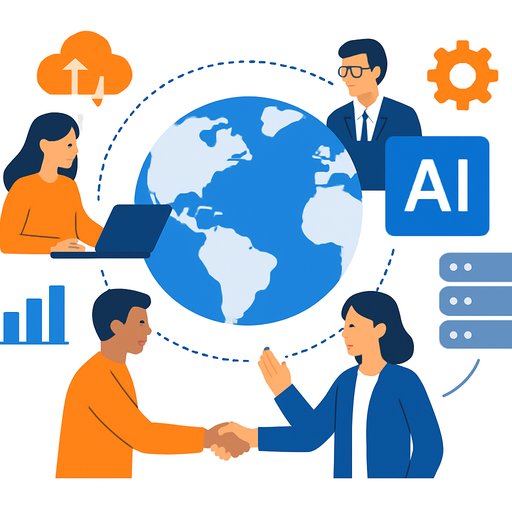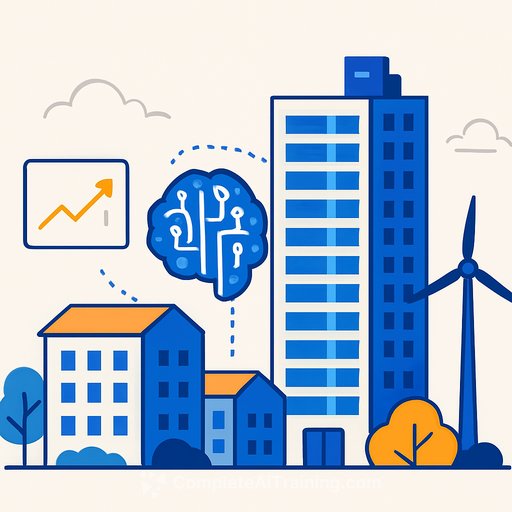AI-Ready Infrastructure, Delivered End-to-End: What This Means for Real Estate and Construction
The message is clear: a new global collaboration is bringing a scalable, turnkey model for end-to-end delivery of AI-ready infrastructure. For developers, owners, and contractors, that means faster starts, predictable outcomes, and less friction across design, build, and operations.
If you manage sites, portfolios, or capital projects, this approach reduces uncertainty. Standardized components, repeatable processes, and a single delivery spine help keep schedules and budgets intact.
Why it matters
- Speed to market: Pre-approved designs, vendor kits, and prefab shorten lead times.
- Cost control: Standard SKUs, volume pricing, and fewer change orders stabilize spend.
- Risk reduction: One accountable team from site due diligence through commissioning and handover.
- Future-ready assets: Buildings and campuses wired for AI workloads from day one.
What "AI-ready" looks like on your projects
- Power and cooling: Higher-density electrical, smart switchgear, and liquid/air hybrid cooling options sized for AI racks.
- Network and edge: Redundant fiber, low-latency edge rooms, and structured cabling that scales without rework.
- Data backbone: Sensors, BMS/EMS, and OT data pipelines that feed analytics and automation.
- Security by design: Segmented networks, access controls, and audit-ready logging for OT/IT.
- Digital twin/BIM: Asset data standardized for operations, not just construction.
- Modular delivery: Prefab MEP racks, skids, and micro data center pods to compress schedules.
The turnkey delivery model, step by step
- Site and power: Grid capacity checks, substation planning, and utility coordination early.
- Standard design kits: Pre-engineered architecture for compute rooms, power blocks, and cooling plants.
- Procurement: Locked suppliers for GPUs/servers, switchgear, chillers, racks, and containment.
- Prefabrication: Offsite assembly of critical MEP and IT components.
- Construction: Parallel workstreams for civil, structural, and MEP to speed throughput.
- Commissioning: Integrated OT/IT testing, load banks, and performance baselines.
- Operate: SLAs, remote monitoring, and lifecycle plans baked in at handover.
Where this model fits
- Data centers and edge sites: New builds, expansions, and adaptive reuse.
- Life sciences and R&D: Labs with heavy simulation and imaging workloads.
- Logistics and industrial: AI vision, robotics, and predictive maintenance at scale.
- Commercial and mixed-use: Smart building operations and tenant AI services.
- Healthcare: Diagnostics, scheduling, and secure data platforms.
Budget and ROI: what to expect
AI workloads push density, so electrical and cooling line items rise, but standardization offsets much of the added cost. Prefab and repeatable design reduce rework and delay fees. Over time, better energy efficiency, higher uptime, and fewer site visits trim operating costs.
The key is lifecycle math: total cost of ownership over five to ten years, not just day-one capex. Model energy curves, capacity growth, and refresh cycles before you break ground.
Questions to put on the table
- What rack densities (kW/rack) are supported now and in the next two phases?
- Which cooling strategies are standardized, and how fast can we switch if loads change?
- What reliability tier and redundancy are assumed? See Uptime Institute Tiers.
- How is OT/IT security handled, and which frameworks are used? Review the NIST Cybersecurity Framework.
- What data standards power the digital twin for operations (naming, handover files, APIs)?
- Which components are prefab, and what's the time saved on site?
Implementation checklist
- Lock site power plan and utility milestones.
- Select a standard design kit sized to your growth curve.
- Pre-book critical gear with alternates for long-lead items.
- Align BIM, asset tagging, and handover data with FM needs.
- Define SLAs for uptime, response times, and energy targets.
- Run a pilot space (edge room or module) before full rollout.
Upskill your team
Field teams, facility managers, and project execs need practical AI and data literacy to get value from these assets. If you're building a training path, explore role-based options here: AI courses by job.
Bottom line
The new global collaboration introduces a scalable, turnkey model that enables seamless end-to-end delivery of AI-ready infrastructure. For real estate and construction, that translates to predictable builds, faster delivery, and assets that stay useful as compute needs grow.
Start with one pilot, lock your standards, then roll the model across your portfolio. Simple, repeatable, and built for what's coming next.
Your membership also unlocks:






